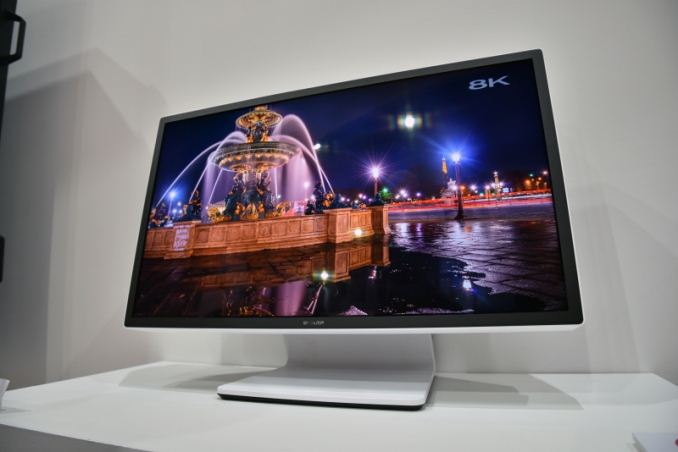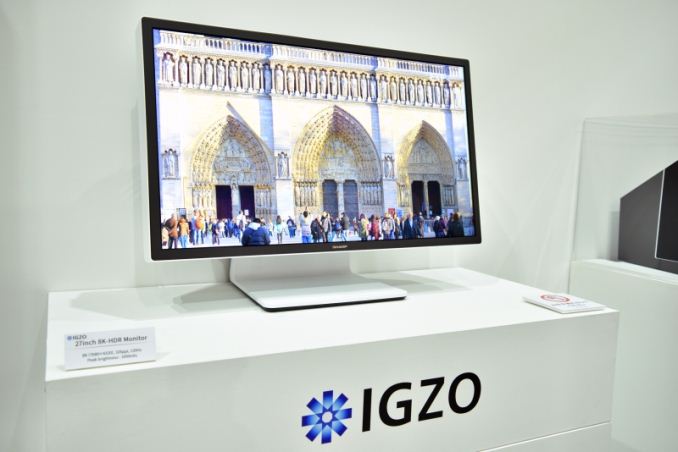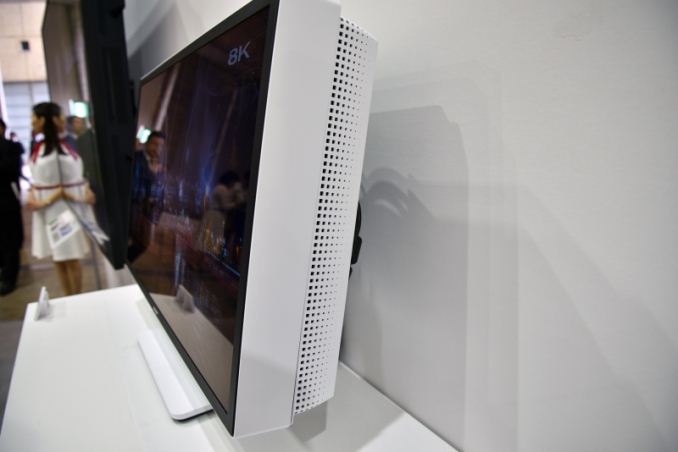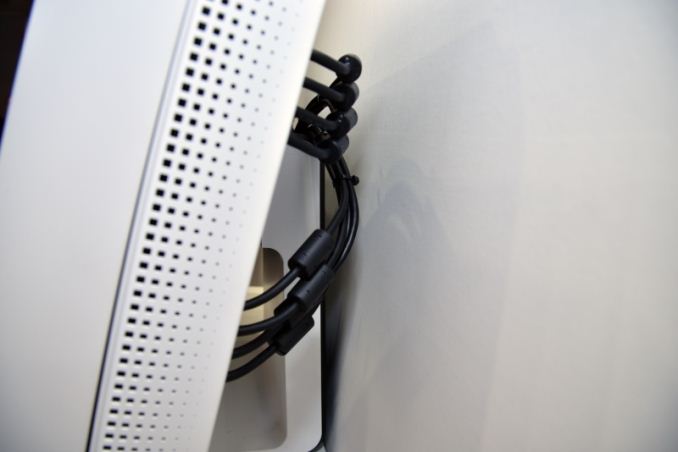CEATEC 2016: Sharp Showcases 27-inch 8K 120Hz IGZO Monitor with HDR, also 1000 PPI for VR
by Ian Cutress on October 5, 2016 10:15 AM EST- Posted in
- Monitors
- 120Hz
- DisplayPort
- Trade Shows
- Sharp
- IGZO
- 8K
- HDR
- CEATIC

While we’re not CEATEC, a Japanese technology show, news has come via PC Watch regarding a new publicly announced milestone in monitor production. For any journalist that has attended either IFA, Computex, CES or MWC over the past year, it would be hard going to miss one of the super large (80-inch plus) 8K monitors doing the rounds. While highly impressive in their own right, current 8K displays on show typically have a low pixel-per-inch value in order to achieve a good panel off the production line. So despite the fact we can get 4K panels on smartphones (Sony Xperia Z5 Premium is 4K in 5.5-inch, or 806 PPI), expanding the size at that pixel density is difficult with panel yields. Also, moving 8K down to a 'monitor size' has been hidden at the panel companies internal research divisions until now.
So this is where the Sharp monitor on display at CEATEC gets interesting. The IGZO display is down at 27-inches, marking a 326 PPI, just hitting at the door of large FHD smartphone displays. The panel is also listed at 1000 nit brightness. But to double down on specifications, the stand listed the display as supporting 120 Hz while in 8K mode, and also supporting High Dynamic Range, or HDR. This requires a large amount of data to be pumped into the display, and as a result a photograph of the rear shows eight separate DisplayPort cables being used in order to give the display the data it needs. 8K120 with HDR is no easy task, suggesting 7680x4320 at 10 bits per color channel (so 30-bit for RGB) at 120 times a second would suggest needing 120 gigabits per second of bandwidth at a minimum (or 15 GB/sec). That's even before you discuss overhead, which will push that higher.
Needless to say, this is a prototype panel. Businesses with large enough checkbooks are free to try and estimate a figure for such a display, because it will be a while before a device of these specifications hits commercial availability.
Also in the display was a 2.87-inch display, offering 1920x2160 resolution and rolling in at over 1000 pixels per inch (1008 PPI). This was described as ‘4K to both eyes’, affording a combined display suitable for head-mounted units or virtual reality headsets. Compare this to the HTC Vive, which uses a 1200x1080 screen per eye at 3.62 inches per panel, making it 447 PPI. This gives the Sharp panel a specification of over double the amount of pixels in a given area. Of course, with that comes cost and the ability to feed that display with enough data either over cable or other means. Still, it’s an interesting prospect.
Source: PC Watch














44 Comments
View All Comments
Lolimaster - Wednesday, October 5, 2016 - link
I would personally love a 2560x1440 or even bettwe 3000x2000 3000:1 VA/OLED with 240Hz @30inches.Toss3 - Wednesday, October 5, 2016 - link
Anything above 1440p with HDR and 100hz+ would do. These 27" 1080p crappy displays the manufacturers keep churning out are just ridiculous (money grab).Galvin - Wednesday, October 5, 2016 - link
Rate we're going. We'll have 20k displays in 10 years time. Where do diminishing returns start at though. How small can a pixel get before it don't matter anymore?stephenbrooks - Thursday, October 6, 2016 - link
20-20 vision is supposed to be a resolution of a "minute of arc", or 360*60 = 21600 pixels per *360 degrees*. So even well-implemented 4K is probably close to saturating what a human being can see over a monitor-sized FOV (70 degrees say).For VR, the FOV is wider so 8K will be required for realism. I'm really excited that they're making progress for VR displays above what Oculus/Vive have done.
satai - Wednesday, October 5, 2016 - link
447 vs 1008 PPI is not over double the pixels in a given area. It's over five times the pixels.Toss3 - Wednesday, October 5, 2016 - link
Well if that given area is a straight line then that statement is correct.satai - Wednesday, October 5, 2016 - link
There is no such thing as an area, that is a straight line.pwnish3r - Wednesday, October 5, 2016 - link
Sure there is. A line that is 200x1 units would occupy an area of 200 units. A straight line does not have to be infinitely thin, as you assume.chaos215bar2 - Wednesday, October 5, 2016 - link
It's pretty simple. Choose an area of the screen. Increase the pixel density from 447 to 1008 PPI. Now you have ~5x the pixels in that area. Those 200x1 pixels (or whatever unit you prefer) become 451x2.25.If you're talking about a single row or column of pixels and ignoring the other dimension, that's no longer area.
Communism - Wednesday, October 5, 2016 - link
It's annoying that no-one is doing (and likely no one will ever do) a 215.766 hz 10 bit per pixel without trickery IGZO IPS mode 2560 x 1440 G-Sync display on DP 1.4.IGZO IPS mode is just begging to be put into high refresh rate displays, but the market never seems to be able to ramp up any display technology that is more expensive than TN and, more recently, IPS.